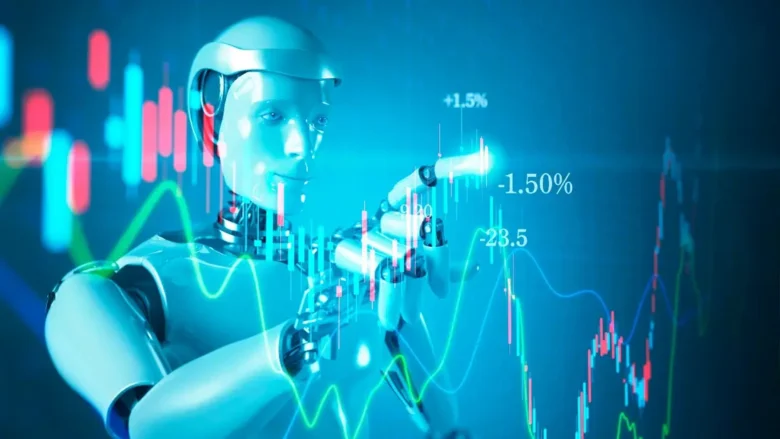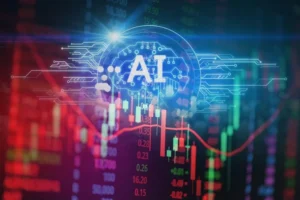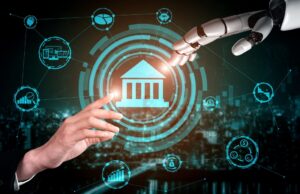Artificial intelligence (AI) has revolutionized the world of stock trading. Smart algorithms and data-driven tools now make it possible to do things that once required milliseconds in crowded trading rooms. AI stock trading, also known as algorithmic trading or automated trading, is quickly becoming a key component of modern financial planning. AI is helping everyone from hedge funds to individual investors make faster, more accurate decisions with data-driven ideas that outperform traditional methods.
So, how do these smart tools work? How do these “bots” choose their trading targets? Can they beat human traders? As we invest more and more money in machines, these questions become crucial. We’ll demystify AI stock trading and show you how it works, what drives it, how it thinks, and why it will change our business model forever.
Essence of AI Stock Trading: Data and Algorithms
AI for stock trading is based on data—lots of data. Every decision made by AI trading robots is based on a vast amount of historical stock data, real-time market dynamics, financial news, social sentiment, and even events in other countries. AI systems use this information to look for patterns and trends, allowing them to predict future price movements with astonishing accuracy. Machine learning algorithms are used to train these systems. These algorithms continue to improve as the amount of data increases. It’s like teaching a robot to find lucky lottery numbers—not by luck, but by looking at millions of previous lottery results and predicting what will happen in most cases. Algorithms process this data much faster than humans, allowing them to recognize opportunities and act within milliseconds. With this speed and analytical power, AI traders have a huge advantage over traditional trading methods.
Machine Learning vs. Predictive Models:
With the help of machine learning, AI trading continues to improve over time. Machine learning models change over time, while rule-based systems follow a strict “if-then” logic. They learn from market behavior and continue to improve their predictive abilities as more information comes in. To predict future price movements, these models are usually based on historical stock market data, such as price, volume, and volatility. Neural networks are one of the most advanced methods available today. They work like the human brain, finding complex relationships in data. AI can use numbers to understand how people think about the market and can analyze news stories, earnings reports, and even Twitter trends. In other words, an AI trading bot can predict that a stock price will rise minutes after a positive news item goes viral, faster and more accurately than a human trader. The bot is constantly learning and improving, so the AI’s plans get better over time, making them more accurate and profitable.
High-Frequency and Fast Trading:
AI stock trading excels when speed is critical, such as in high-frequency trading (HFT). These trading bots operate extremely quickly, completing thousands of trades per second based on real-time market dynamics. With faster speeds, the bots can more often take advantage of small price differences between venues. For example, if one market prices a stock slightly lower than another, the AI can buy the stock at that lower price and then repeatedly sell it for a small profit. Even if the profit on a single trade is small, the total profit is crucial. This type of trading is not just about speed but also about accuracy. Even a small mistake can lead to huge losses, so AI systems are designed to be extremely accurate and always self-correcting. Thanks to the power of artificial intelligence (AI), high-frequency trading (HFT) has become a major force in global markets.
Manage Risk, Make Decisions Without Emotions:
One of the great advantages of AI trading over humans is that it can make decisions without being influenced by emotions. Humans often lose control when the market is falling or become overconfident when it is rising. These emotions can cause people to sell without thinking, resulting in huge losses. AI, on the other hand, uses data and reasoning and does not change its mind or get scared or excited. This makes it a great tool for risk management. AI trading systems set strict risk parameters so that they know when to exit a trade, when to stop losses, and when to hold a position. They can even spread risk and protect capital by executing different types of trades. Some systems use predictive analysis to predict when the market will fall and adjust stock prices accordingly. Because AI is emotionless, it can maintain a level of discipline and consistency that human traders can hardly match. This robust strategy can make the difference between profit and loss in volatile markets.
The Human Factor: The Limitations and Regulations
As powerful as AI trading is, it’s not perfect. Not only can machines process data and spot patterns faster than humans, but they also lack true intuition. Sudden political crises, natural disasters, or regulatory changes can cause markets to move in ways that no model can predict. In these situations, thinking ahead is essential. That’s why many trading firms use hybrid models that combine AI with human control. Traders monitor the AI’s choices, intervene when necessary, and adjust their strategies as market conditions change.
Another issue is that AI models, especially deep learning models, can seem like “black boxes,” meaning it’s not always clear why they make the choices they do. In addition, regulators intervene to ensure that AI trading doesn’t undermine market stability. Even when robots operate in the background, someone must maintain a broad perspective. This combination of automation and human control is why AI stock trading really works.
Conclusion:
AI stock trading is no longer a fantasy of the future; it is real and is changing the way markets operate. AI has enormous potential in modern finance because it can analyze large amounts of data, learn from past behavior, complete trades in milliseconds, and manage risk without any perception. However, it is not a panacea. No matter how powerful AI becomes, it still requires human input and oversight to ensure it trades responsibly and can respond to unexpected events. To be both powerful and effective, AI trading requires the precision of a machine and the judgment of a human. As the technology continues to develop, we can expect trading systems to become smarter, faster, and more user-friendly. The future of stock trading is already here and is being driven by smart robots running in the background.
FAQs:
1. How does AI trade stocks?
AI stock trading uses machine learning and AI algorithms to analyze market data and automatically execute trades.
2. How does AI determine what to trade?
AI can predict stock movements and use models trained on historical data, current news, and market trends to determine the next move.
3. Is trading with AI better than trading with humans?
AI excels at making decisions quickly, correctly, and unconsciously, but still requires close human supervision when things go wrong.
4. Can I trade with AI as a regular trader?
Yes, many websites now offer AI-driven tools for individual investors, such as robo-advisors and automated trading software.
5. What are the risks of letting AI trade stocks?
AI can make mistakes if not monitored closely, and overreliance on models can cause problems when the market changes rapidly or a “black swan” event occurs.




